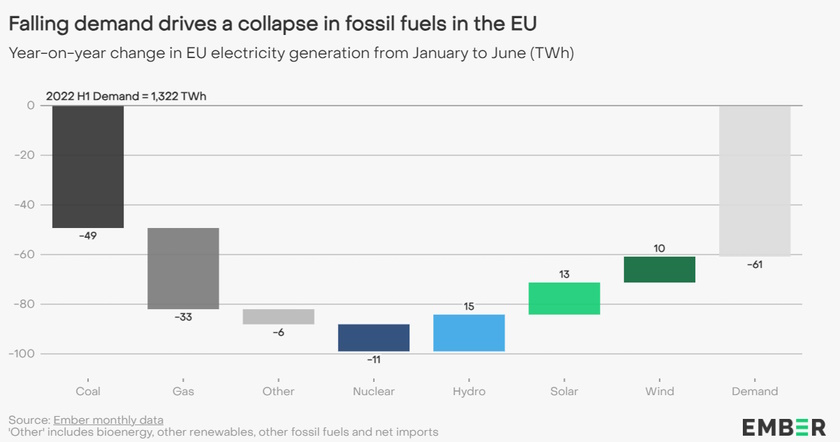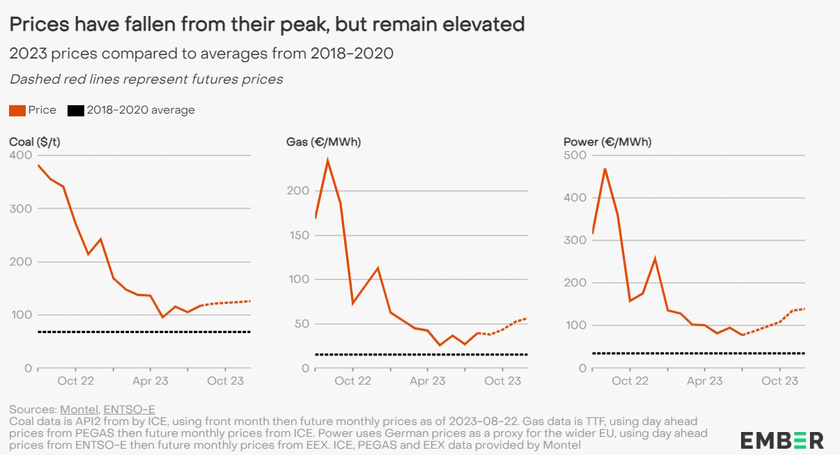
Photo: Martina Janochová from Pixabay
The first half of 2023 saw a collapse in the production of electricity from fossil fuels in the European Union to the lowest level on record, think tank Ember said.
The slump in power output from fossil fuels, according to Ember, was predominantly driven by a significant drop in electricity demand amid persistently high gas and power prices, a reduction in industrial output, and emergency measures over winter. Fossil fuel prices have dropped from crisis highs, but remain elevated compared to before the gas crunch began.
EU fossil generation from January to June was 17% or 86 TWh under the level registered in the same period of 2022. At 410 TWh, it was the lowest since at least 2000, while demand reached a record low 33%.
The drop in the use of fossil fuels for the production of electricity was Europe-wide
Coal generation decreased by 23% or 49 TWh year on year, compared to 13% (33 TWh) for gas.
The fossil fuel drop was Europe-wide, with at least 20% in eleven countries, and more than 30% in five (Portugal, Austria, Bulgaria, Estonia, Finland). Fourteen countries saw their lowest total fossil generation on record for the period. Austria, Czechia, Denmark, Finland, Italy, Poland, and Slovenia registered the lowest output of electricity from fossil fuels since at least 2000, Ember said in the report.
Wind and solar are leading the renewables charge
Growth in solar power continued in the first half of the year, with generation up 13% from the same period in 2022. The wind segment rose by 5%, while hydropower recovered towards average levels with growth reaching 11%.
From January through June, 17 countries generated record shares of power from renewables, with Greece and Romania passing 50% for the first time and Denmark and Portugal both breaking the 75% mark.
High energy prices, emergency measures, mild weather push down demand

Amid high energy prices, emergency measures, and mild winter, electricity demand fell substantially to a record low of 1,261 TWh, below even 2020’s pandemic low of 1,271 TWh and the lowest since at least 2008 for current member states.
The drop was responsible for the majority of the decrease in fossil generation in the EU, Ember said.
The reduction in electricity demand in the first half was 4.6% (or 61 TWh) on an annual scale.
It is clear that demand destruction is also playing a role
Industrial demand fall has been particularly acute in Germany, where output from energy-intensive industries decreased 15% to 20% from its 2021 average. Weakening also occurred in the EU’s other major industrial centers: Italy, France, Spain, Poland, and the Netherlands.
While some of the fall in demand can be attributed to energy efficiency, demand side response, and unmeasured solar generation, it is clear that demand destruction is also playing a role, adding to concerns about the competitiveness of European industry, Ember stressed.
Prices lowered than in 2022, but still above 2021 levels

According to Ember, EU fossil gas prices have dropped from crisis highs, but remain elevated compared to before the gas crunch began. The average came in at EUR 44 per MWh in the first half or more than 50% below the level from one year before – EUR 97 per MWh. However, the measure is two times higher than in the firs half of 2021 (EUR 22 per MWh).
Gas price surge risks are increasing as winter and the heating season approaches.
Coal price numbers are similar. Rotterdam prices have averaged USD 134 per ton, compared to USD 275 per ton from the first half of 2022. However, as with gas, coal is still much more expensive than before the start of the gas crisis: it cost USD 78 per ton in the same period of 2021.
Due to fossil fuels’ price-setting role in Europe’s power system, electricity prices also remained high, at an average of EUR 107 per MWh or more than 40% under the level from the same period of last year (EUR 185 per MWh). The reference price in the first half of 2021 was EUR 55 per MWh), Ember added.


















Be the first one to comment on this article.